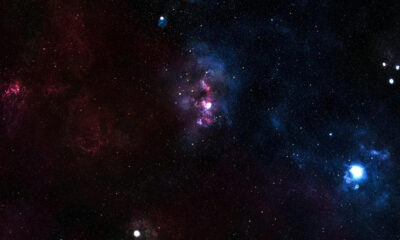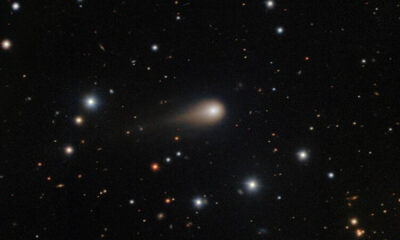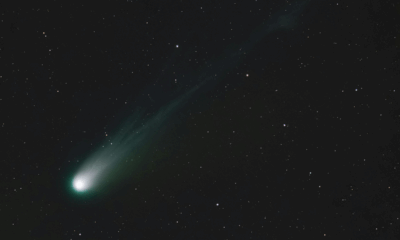Science
Cosmic Collision: 3I/ATLAS and Solar Explosion Set for Major Test

A significant astronomical event is occurring as the interstellar object 3I/ATLAS approaches a violent explosion from the Sun, known as a coronal mass ejection. This unique interaction is set to provide critical insights into the object’s nature. Discovered on July 1, 2025, by the ATLAS survey in Chile, 3I/ATLAS is just the third observed interstellar object, making this event highly anticipated among astronomers. The object’s closest approach to the Sun, or perihelion, took place on October 29, 2025, and the scientific community is now eagerly awaiting the data that will emerge from this unprecedented encounter.
The significance of this event extends beyond mere spectacle. When the Sun’s plasma cloud collides with 3I/ATLAS, its response could reveal vital information about its composition, density, and origins from a distant star system. Previous interactions between solar activity and celestial bodies have been recorded, but this particular scenario is unprecedented. The last notable interaction occurred in April 2007, when an asteroid from within our solar system encountered a similar solar blast. Observations from NASA’s STEREO A spacecraft showed that the asteroid briefly lost its tail, but it quickly reformed.
In contrast, 3I/ATLAS is not a familiar asteroid; it is a massive object weighing up to 33 billion tons with an estimated nucleus size ranging from 440 meters to 5.6 kilometers wide. Recent observations from the James Webb Space Telescope and Hubble have confirmed that it is an active comet with an unusual composition that includes significant amounts of nickel. This raises questions about how it will react to the solar blast: will it remain intact, or will it lose its outer layers?
As 3I/ATLAS approaches Mars, it will come into view of more powerful telescopes, enabling detailed analysis. The Virtual Telescope Project plans to livestream new observations on November 16. These observations aim to confirm the object’s identity and understand its behavior following the solar blast.
The scientific community is particularly intrigued by theories surrounding 3I/ATLAS. Harvard astronomer Avi Loeb has suggested that the object’s unusual velocity of 137,000 miles per hour and its peculiar shape—along with jets that appear to point towards the Sun—could indicate that it is an alien craft. He posits that it might be an asteroid modified by intelligent life.
Despite these theories, NASA maintains a more cautious stance, emphasizing natural explanations for the object’s characteristics. A recent discovery by astronomers using the MeerKAT radio telescope in South Africa detected a faint radio signal from 3I/ATLAS, identifying hydroxyl radicals (OH) associated with water vapour. This is a typical sign of a comet’s ice sublimating into gas as it is heated by solar energy. NASA believes that upcoming observations will clarify the object’s nature and may ultimately dispel the “alien craft” hypothesis.
As the scientific world awaits the data, the implications of this cosmic encounter remain profound. Will the interaction confirm 3I/ATLAS as a natural comet, as suggested by the hydroxyl detection, or will it present anomalies that reignite discussions about extraterrestrial origins? The answers are on the horizon as astronomers prepare to analyze the aftermath of this rare celestial event.
-

 Entertainment3 months ago
Entertainment3 months agoAnn Ming Reflects on ITV’s ‘I Fought the Law’ Drama
-

 Entertainment4 months ago
Entertainment4 months agoKate Garraway Sells £2 Million Home Amid Financial Struggles
-

 Health2 months ago
Health2 months agoKatie Price Faces New Health Concerns After Cancer Symptoms Resurface
-

 Entertainment3 months ago
Entertainment3 months agoCoronation Street’s Carl Webster Faces Trouble with New Affairs
-

 Entertainment2 months ago
Entertainment2 months agoWhere is Tinder Swindler Simon Leviev? Latest Updates Revealed
-

 Entertainment4 months ago
Entertainment4 months agoMarkiplier Addresses AI Controversy During Livestream Response
-

 Science4 weeks ago
Science4 weeks agoBrian Cox Addresses Claims of Alien Probe in 3I/ATLAS Discovery
-

 Entertainment4 months ago
Entertainment4 months agoKim Cattrall Posts Cryptic Message After HBO’s Sequel Cancellation
-

 Entertainment2 months ago
Entertainment2 months agoOlivia Attwood Opens Up About Fallout with Former Best Friend
-

 Entertainment3 months ago
Entertainment3 months agoMasterChef Faces Turmoil as Tom Kerridge Withdraws from Hosting Role
-

 Entertainment4 months ago
Entertainment4 months agoSpeculation Surrounds Home and Away as Cast Departures Mount
-

 World2 months ago
World2 months agoCole Palmer’s Mysterious Message to Kobbie Mainoo Sparks Speculation





















